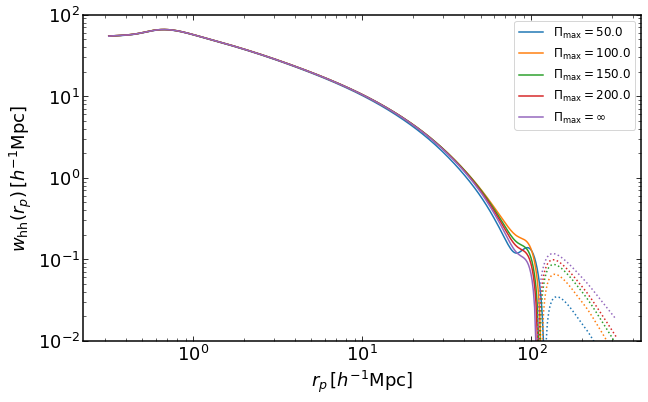darkemu module tutorial notebook
%load_ext autoreload
%autoreload 2
%pylab inline
import logging
mpl_logger = logging.getLogger('matplotlib')
mpl_logger.setLevel(logging.WARNING)
Populating the interactive namespace from numpy and matplotlib
plt.rcParams['font.family'] = 'sans-serif'
plt.rcParams['font.size'] = 18
plt.rcParams['axes.linewidth'] = 1.5
plt.rcParams['xtick.major.size'] = 5
plt.rcParams['ytick.major.size'] = 5
plt.rcParams['xtick.minor.size'] = 3
plt.rcParams['ytick.minor.size'] = 3
plt.rcParams['xtick.top'] = True
plt.rcParams['ytick.right'] = True
plt.rcParams['xtick.minor.visible'] = True
plt.rcParams['ytick.minor.visible'] = True
plt.rcParams['xtick.direction'] = 'in'
plt.rcParams['ytick.direction'] = 'in'
plt.rcParams['figure.figsize'] = (10,6)
from dark_emulator import darkemu
emu = darkemu.base_class()
initialize cosmo_class
Initialize pklin emulator
initialize propagator emulator
Initialize sigma_d emulator
initialize cross-correlation emulator
initialize auto-correlation emulator
Initialize sigmaM emulator
initialize xinl emulator
how to set cosmology
cparam = np.array([0.02225,0.1198,0.6844,3.094,0.9645,-1.])
emu.set_cosmology(cparam)
how to plot halo-mass cross correlation for mass threshold halo samples
rs = np.logspace(-2,2.5,200)
plt.figure(figsize=(10,6))
z = 0
for i, Mmin in enumerate(np.logspace(12,15,7)):
xihm = emu.get_xicross_massthreshold(rs,Mmin,z)
plt.loglog(rs,xihm,color="C{}".format(i),label='$M_\mathrm{th}=%0.2g$' %Mmin)
plt.loglog(rs,-xihm,':',color="C{}".format(i))
plt.legend(fontsize=12)
plt.ylim(0.00001,1000000)
plt.xlabel("$x\,[h^{-1}\mathrm{Mpc}]$")
plt.ylabel("$\\xi_\mathrm{hm}(x)$")
Text(0, 0.5, '$\xi_\mathrm{hm}(x)$')
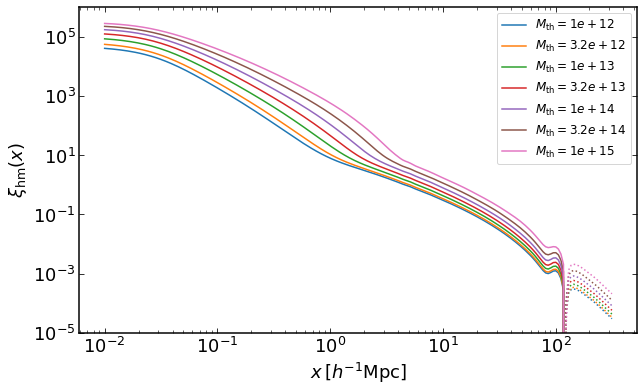
how to plot DeltaSigma(R) for a mass threshold halo samples
rs = np.logspace(-1.5,2.5,100)
plt.figure(figsize=(10,6))
z = 0
for i, Mmin in enumerate(np.logspace(12,15,7)):
dsigma = emu.get_DeltaSigma_massthreshold(rs,Mmin,z)
plt.loglog(rs,dsigma,label='$M_\mathrm{th}=%0.2g$' %Mmin)
plt.legend(fontsize=12)
plt.ylim(0.002,1000)
plt.xlabel("$r_p\,[h^{-1}\mathrm{Mpc}]$")
plt.ylabel("$\Delta\Sigma(r_p)\,[h M_\odot \mathrm{pc}^{-2}]$")
Text(0, 0.5, '$\Delta\Sigma(r_p)\,[h M_\odot \mathrm{pc}^{-2}]$')

how to plot halo-halo correlation for mass threshold halo samples
rs = np.logspace(-0.5,2.5,400)
plt.figure(figsize=(10,6))
z = 0
for i, Mmin in enumerate(np.logspace(12,14,5)):
xih = emu.get_xiauto_massthreshold(rs,Mmin,z)
plt.loglog(rs,xih,color="C{}".format(i),label='$M_\mathrm{th}=%0.2g$' %Mmin)
plt.loglog(rs,-xih,':',color="C{}".format(i))
plt.legend(fontsize=12)
plt.ylim(0.0001,20)
plt.xlabel("$x\,[h^{-1}\mathrm{Mpc}]$")
plt.ylabel("$\\xi_\mathrm{hh}(x)$")
Text(0, 0.5, '$\xi_\mathrm{hh}(x)$')

how to plot halo-halo projected correlation function for mass threshold halo samples
rs = np.logspace(-0.5,2.5,400)
z = 0
plt.figure(figsize=(10,6))
for i, Mmin in enumerate(np.logspace(12,14,5)):
wh = emu.get_wauto_massthreshold(rs,Mmin,z)
plt.loglog(rs,wh,color="C{}".format(i),label='$M_\mathrm{th}=%0.2g$' %Mmin)
plt.loglog(rs,-wh,':',color="C{}".format(i))
plt.legend(fontsize=12)
plt.xlabel("$r_p\,[h^{-1}\mathrm{Mpc}]$")
plt.ylabel("$w_\mathrm{hh}(r_p)\,[h^{-1}\mathrm{Mpc}]$")
Text(0, 0.5, '$w_\mathrm{hh}(r_p)\,[h^{-1}\mathrm{Mpc}]$')
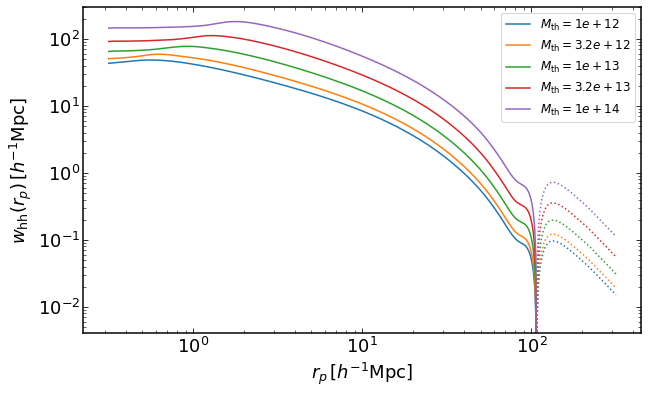
Same as before, but for halos with fixed masses instead of mass threshold samples.
rs = np.logspace(-2,2.5,200)
plt.figure(figsize=(10,6))
for i, M in enumerate(np.logspace(12,15,7)):
xihm = emu.get_xicross_mass(rs,M,z)
plt.loglog(rs,xihm,color="C{}".format(i),label='$M=%0.2g$' %M)
plt.loglog(rs,-xihm,':',color="C{}".format(i))
plt.legend(fontsize=12)
plt.ylim(0.00001,1000000)
plt.xlabel("$x\,[h^{-1}\mathrm{Mpc}]$")
plt.ylabel("$\\xi_\mathrm{hm}(x)$")
rs = np.logspace(-1.5,2.5,100)
plt.figure(figsize=(10,6))
for i, M in enumerate(np.logspace(12,15,7)):
dsigma = emu.get_DeltaSigma_mass(rs,M,z)
plt.loglog(rs,dsigma,label='$M=%0.2g$' %M)
plt.legend(fontsize=12)
plt.ylim(0.002,1000)
plt.xlabel("$r_p\,[h^{-1}\mathrm{Mpc}]$")
plt.ylabel("$\Delta\Sigma(r_p)\,[h M_\odot \mathrm{pc}^{-2}]$")
rs = np.logspace(-0.5,2.5,400)
plt.figure(figsize=(10,6))
for i, M in enumerate(np.logspace(12,14,5)):
xih = emu.get_xiauto_mass(rs,M,M,z)
plt.loglog(rs,xih,color="C{}".format(i),label='$M=%0.2g$' %M)
plt.loglog(rs,-xih,':',color="C{}".format(i))
plt.legend(fontsize=12)
plt.ylim(0.0001,40)
plt.xlabel("$x\,[h^{-1}\mathrm{Mpc}]$")
plt.ylabel("$\\xi_\mathrm{hh}(x)$")
rs = np.logspace(-0.5,2.5,400)
plt.figure(figsize=(10,6))
for i, M in enumerate(np.logspace(12,14,5)):
wh = emu.get_wauto_mass(rs,M,M,z)
plt.loglog(rs,wh,color="C{}".format(i),label='$M=%0.2g$' %M)
plt.loglog(rs,-wh,':',color="C{}".format(i))
plt.legend(fontsize=12)
plt.xlabel("$r_p\,[h^{-1}\mathrm{Mpc}]$")
plt.ylabel("$w_\mathrm{hh}(r_p)\,[h^{-1}\mathrm{Mpc}]$")
Text(0, 0.5, '$w_\mathrm{hh}(r_p)\,[h^{-1}\mathrm{Mpc}]$')
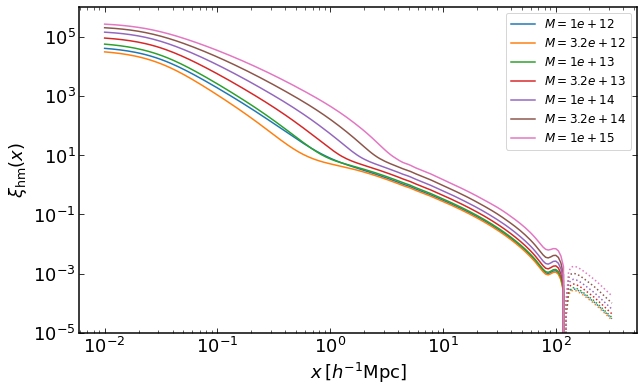

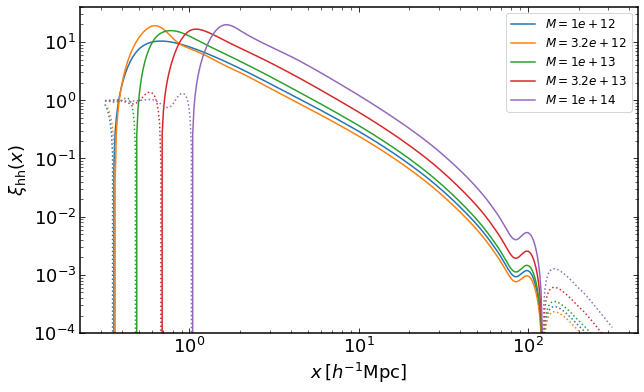
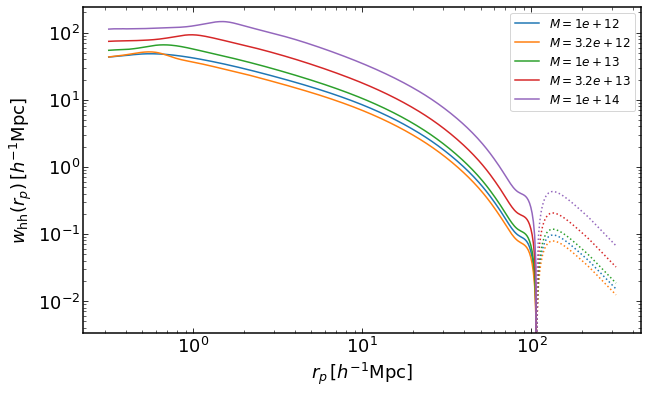
Halo-halo correlation function for halos with 2 different masses
rs = np.logspace(-0.5,2.5,400)
Ms = np.logspace(12,14,3)
plt.figure(figsize=(10,6))
ii = 0
for i in range(3):
for j in range(i,3):
xih = emu.get_xiauto_mass(rs,Ms[i],Ms[j],z)
plt.loglog(rs,xih,color="C{}".format(ii),label='$M_1=%0.2g,\,M_2=%0.2g$' %(Ms[i],Ms[j]))
plt.loglog(rs,-xih,':',color="C{}".format(ii))
ii+=1
plt.legend(fontsize=12)
plt.ylim(0.0001,40)
plt.xlabel("$x\,[h^{-1}\mathrm{Mpc}]$")
plt.ylabel("$\\xi_\mathrm{hh}(x)$")
rs = np.logspace(-0.5,2.5,400)
plt.figure(figsize=(10,6))
ii = 0
for i in range(3):
for j in range(i,3):
wh = emu.get_wauto_mass(rs,Ms[i],Ms[j],z)
plt.loglog(rs,wh,color="C{}".format(ii),label='$M_1=%0.2g,\,M_2=%0.2g$' %(Ms[i],Ms[j]))
plt.loglog(rs,-wh,':',color="C{}".format(ii))
ii+=1
plt.legend(fontsize=12)
plt.xlabel("$r_p\,[h^{-1}\mathrm{Mpc}]$")
plt.ylabel("$w_\mathrm{hh}(r_p)\,[h^{-1}\mathrm{Mpc}]$")
Text(0, 0.5, '$w_\mathrm{hh}(r_p)\,[h^{-1}\mathrm{Mpc}]$')


Projected Halo-halo correlation function with finite projection widths
This takes more time because of an additional direct integration, which is bypassed by using pyfftlog in other routines.
plt.figure(figsize=(10,6))
ii = 0
M = 1e13
for i, pimax in enumerate(np.linspace(50,200,4)):
wh = emu.get_wauto_mass_cut(rs,M,M,z,pimax)
plt.loglog(rs,wh,color="C{}".format(i),label='$\Pi_\mathrm{max}=%.1f$' %(pimax))
plt.loglog(rs,-wh,':',color="C{}".format(i))
wh = emu.get_wauto_mass(rs,M,M,z)
plt.loglog(rs,wh,color="C{}".format(4),label='$\Pi_\mathrm{max}=\infty$')
plt.loglog(rs,-wh,':',color="C{}".format(4))
plt.legend(fontsize=12)
plt.xlabel("$r_p\,[h^{-1}\mathrm{Mpc}]$")
plt.ylabel("$w_\mathrm{hh}(r_p)\,[h^{-1}\mathrm{Mpc}]$")
plt.ylim(0.01,100)
(0.01, 100)
